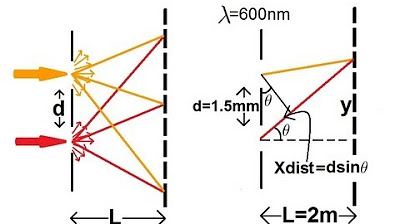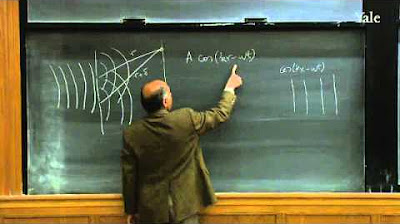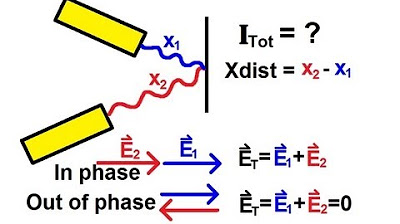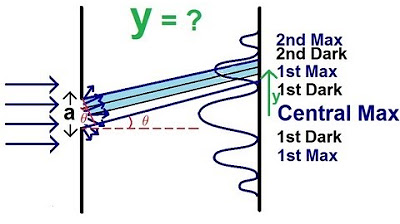Interference Patterns
TLDRThis AP Physics essentials video 111, presented by Mr. Andersen, explores the concept of interference patterns that emerge when two or more wave fronts interact. Using a visual analogy of Jean-Baptiste Le Bouquin's hands creating waves in a pool, the video illustrates how destructive and constructive interference lead to these patterns. It covers the importance of interference in various wave types, particularly light waves, and demonstrates the phenomenon through the double-slit experiment. The video also explains the difference between diffraction and interference, showing how adding a second slit leads to a striking pattern of light and dark bands, indicative of constructive and destructive interference. The educational content is further enhanced with a PHET simulation, aiming to help viewers qualitatively apply the wave model to describe interference patterns.
Takeaways
- 🌊 Interference occurs when two or more wave fronts interact with each other.
- 👐 Jean-Baptiste Le Bouquin demonstrates interference patterns using his hands to create wave fronts.
- 🌀 Destructive interference happens when waves cancel each other out, creating troughs.
- 🏞 Constructive interference results in increased wave amplitude, forming 'mountains' of waves.
- 🌈 Interference patterns are important in various types of waves, including sound, water, and especially light waves.
- 🔄 Wave diffraction is observed when waves encounter a gap similar in size to their wavelength.
- 🎭 Double diffraction patterns are formed when waves pass through two slits of a similar size to their wavelength.
- 💡 The double-slit experiment with monochromatic light produces bands of light, alternating between bright and dark.
- 🌀 Phase matching of waves is crucial for constructive interference, where waves combine to form larger waves.
- 🚫 Out-of-phase waves lead to destructive interference, where they cancel each other out completely.
- 📚 The PHET simulation illustrates the formation of interference patterns with light shining through slits.
Q & A
What is the main topic of this AP Physics essentials video?
-The main topic of this video is interference, specifically the patterns that occur when two or more wave fronts interact.
Who is the French astronomer mentioned in the video that demonstrates interference patterns?
-The French astronomer mentioned is Jean-Baptiste Le Bouquin, who shows how interference patterns can be formed in a pool.
What is an example of how Mr. Andersen illustrates the concept of wave fronts and interference patterns?
-Mr. Andersen uses the analogy of Jean-Baptiste Le Bouquin's hands moving back and forth to create wave fronts and the resulting interference patterns.
What are the two types of interference mentioned in the video?
-The two types of interference mentioned are constructive interference, where waves increase in amplitude, and destructive interference, where waves cancel each other out.
Why are interference patterns important in the context of this video?
-Interference patterns are important because they occur not only in sound and water waves but especially in light waves, which is a key concept in physics.
What is the relationship between wave diffraction and the size of the gap it hits?
-Wave diffraction occurs when waves hit a gap that is around the size of the wavelength, resulting in a diffraction pattern.
What is a double diffraction pattern and how does it relate to interference?
-A double diffraction pattern is created when waves pass through two slits of a size comparable to the wavelength, leading to the formation of interference patterns where the waves from the two slits combine.
What is the monochromatic double slit experiment and what does it demonstrate?
-The monochromatic double slit experiment involves shining light through two slits, resulting in bands of light that demonstrate constructive and destructive interference.
How does the PHET simulation in the video help in understanding interference patterns?
-The PHET simulation visually demonstrates how light waves interact when passing through one or two slits, showing the bright bands of constructive interference and the dark bands of destructive interference.
What happens when light waves are in phase and constructive interference occurs?
-When light waves are in phase and constructive interference occurs, the waves combine to create much larger waves, resulting in bright bands of light.
What does the absence of light directly across from one slit in the double slit experiment indicate?
-The absence of light directly across from one slit in the double slit experiment indicates the presence of destructive interference, where the waves cancel each other out completely.
How does the video conclude in terms of learning objectives?
-The video concludes by asking if the viewer has learned to qualitatively apply the wave model to describe interference patterns, aiming to ensure understanding of the concepts presented.
Outlines
🌌 Introduction to Wave Interference
In this video script, Mr. Andersen introduces the concept of wave interference, a phenomenon that occurs when two or more wave fronts interact. He uses the example of French astronomer Jean-Baptiste Le Bouquin to illustrate how interference patterns can be formed, such as in a pool of water by moving hands back and forth. The script explains that as these wave fronts interact, they create troughs (destructive interference) where waves cancel each other out, and peaks (constructive interference) where waves are amplified. This principle is applicable not only to sound and water waves but also to light waves, which is particularly important in the study of physics. The video also mentions diffraction, which occurs when waves encounter a gap of a size comparable to their wavelength, leading to a diffraction pattern. The double-slit experiment is highlighted as a classic example of interference patterns, where light passing through two slits creates bands of light that alternate between bright and dark, demonstrating constructive and destructive interference.
Mindmap
Keywords
💡Interference
💡Wave Fronts
💡Destructive Interference
💡Constructive Interference
💡Diffraction
💡Double Slit Experiment
💡Wavelength
💡Phase
💡Monochromatic Light
💡PhET Simulation
💡Amplitude
Highlights
Interference patterns occur when two or more wave fronts interact.
Jean-Baptiste Le Bouquin demonstrates interference patterns with hands creating wave fronts.
Destructive interference results in troughs where waves cancel each other out.
Constructive interference creates areas of increased wave amplitude, forming 'mountains of waves'.
Interference patterns are important in sound, water, and especially light waves.
Wave diffraction occurs when waves encounter a gap similar to their wavelength.
Double diffraction patterns are formed when light passes through two slits of similar wavelength size.
The monochromatic double slit experiment produces bands of light with varying brightness.
Wave interference happens when two waves are in phase, leading to constructive interference.
Out-of-phase waves result in destructive interference, completely canceling each other.
The double slit experiment shows alternating areas of constructive and destructive interference.
A PHET simulation is used to visualize light passing through slits and creating interference patterns.
Adding a second slit to the simulation reveals distinct areas of light and darkness due to interference.
The simulation shows how constructive interference leads to bright spots and destructive interference to dark spots.
The video aims to help viewers qualitatively apply the wave model to describe interference patterns.
Transcripts
Browse More Related Video
5.0 / 5 (0 votes)
Thanks for rating:





